Business Management Project: Factors Influencing Employee Engagement
VerifiedAdded on 2023/01/17
|14
|2884
|59
Project
AI Summary
This business management project comprises three tasks: a qualitative case study on Green Human Resource Management (HRM), a quantitative analysis of factors influencing employee engagement, and a literature review of one approach. The qualitative study examines how multinational companies approach Green HRM, identifying factors influencing subsidiaries, and explores the relationship between the environment and HR functions, using case studies of UK Ltd, German Ltd, and Sweden Ltd. The quantitative study investigates factors influencing employee engagement in the Malaysian financial sector, analyzing the impact of empowering leadership, high-performance work practices, and religiosity. Data collection methods include interviews, focus groups, and surveys. The project concludes with findings, recommendations, and a literature review focusing on the strategic positioning of environmental functions and the importance of employee engagement in implementing green HRM approaches.

Business Management
Project
Project
Paraphrase This Document
Need a fresh take? Get an instant paraphrase of this document with our AI Paraphraser
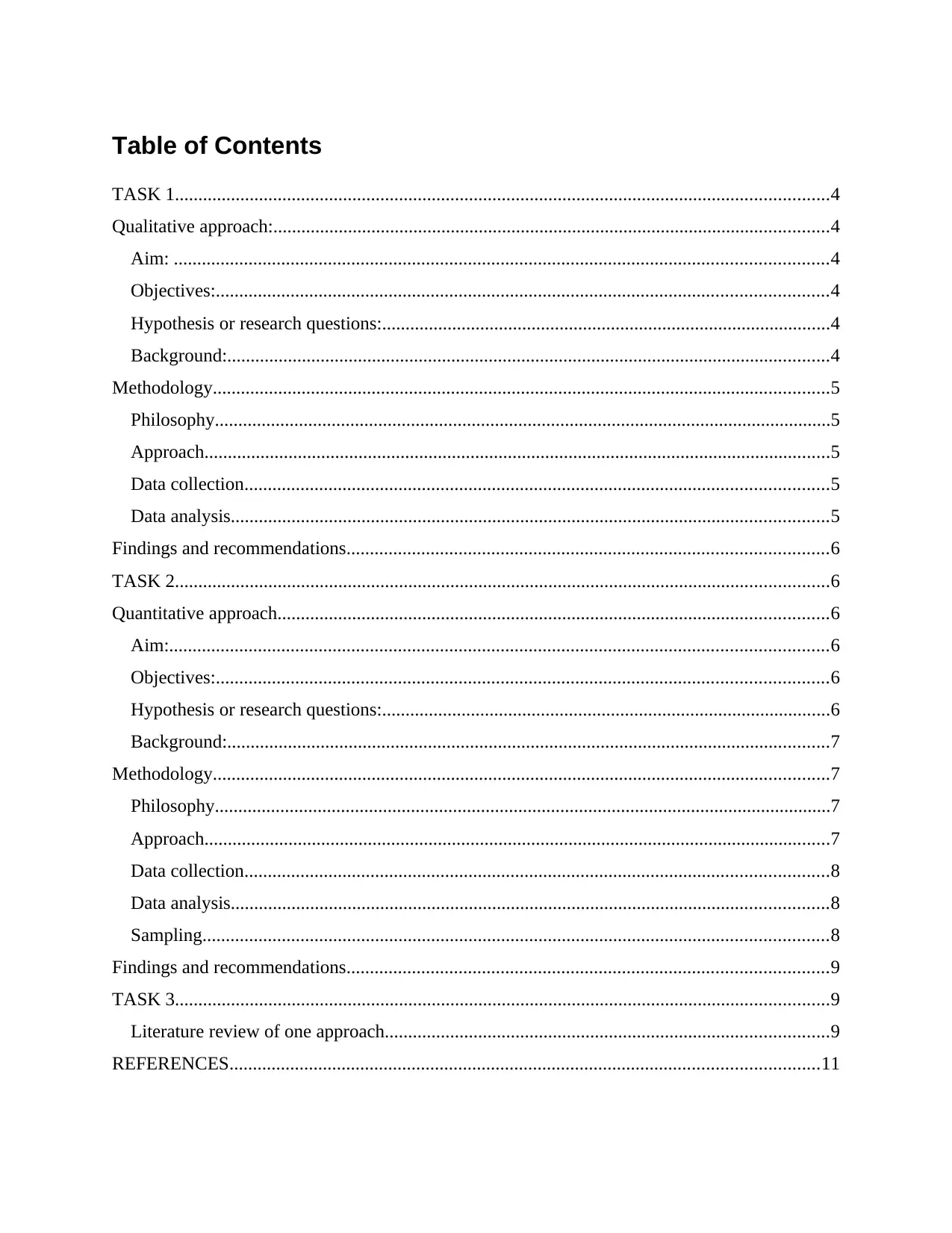
Table of Contents
TASK 1............................................................................................................................................4
Qualitative approach:.......................................................................................................................4
Aim: ............................................................................................................................................4
Objectives:...................................................................................................................................4
Hypothesis or research questions:................................................................................................4
Background:.................................................................................................................................4
Methodology....................................................................................................................................5
Philosophy....................................................................................................................................5
Approach......................................................................................................................................5
Data collection.............................................................................................................................5
Data analysis................................................................................................................................5
Findings and recommendations.......................................................................................................6
TASK 2............................................................................................................................................6
Quantitative approach......................................................................................................................6
Aim:.............................................................................................................................................6
Objectives:...................................................................................................................................6
Hypothesis or research questions:................................................................................................6
Background:.................................................................................................................................7
Methodology....................................................................................................................................7
Philosophy....................................................................................................................................7
Approach......................................................................................................................................7
Data collection.............................................................................................................................8
Data analysis................................................................................................................................8
Sampling......................................................................................................................................8
Findings and recommendations.......................................................................................................9
TASK 3............................................................................................................................................9
Literature review of one approach...............................................................................................9
REFERENCES..............................................................................................................................11
TASK 1............................................................................................................................................4
Qualitative approach:.......................................................................................................................4
Aim: ............................................................................................................................................4
Objectives:...................................................................................................................................4
Hypothesis or research questions:................................................................................................4
Background:.................................................................................................................................4
Methodology....................................................................................................................................5
Philosophy....................................................................................................................................5
Approach......................................................................................................................................5
Data collection.............................................................................................................................5
Data analysis................................................................................................................................5
Findings and recommendations.......................................................................................................6
TASK 2............................................................................................................................................6
Quantitative approach......................................................................................................................6
Aim:.............................................................................................................................................6
Objectives:...................................................................................................................................6
Hypothesis or research questions:................................................................................................6
Background:.................................................................................................................................7
Methodology....................................................................................................................................7
Philosophy....................................................................................................................................7
Approach......................................................................................................................................7
Data collection.............................................................................................................................8
Data analysis................................................................................................................................8
Sampling......................................................................................................................................8
Findings and recommendations.......................................................................................................9
TASK 3............................................................................................................................................9
Literature review of one approach...............................................................................................9
REFERENCES..............................................................................................................................11
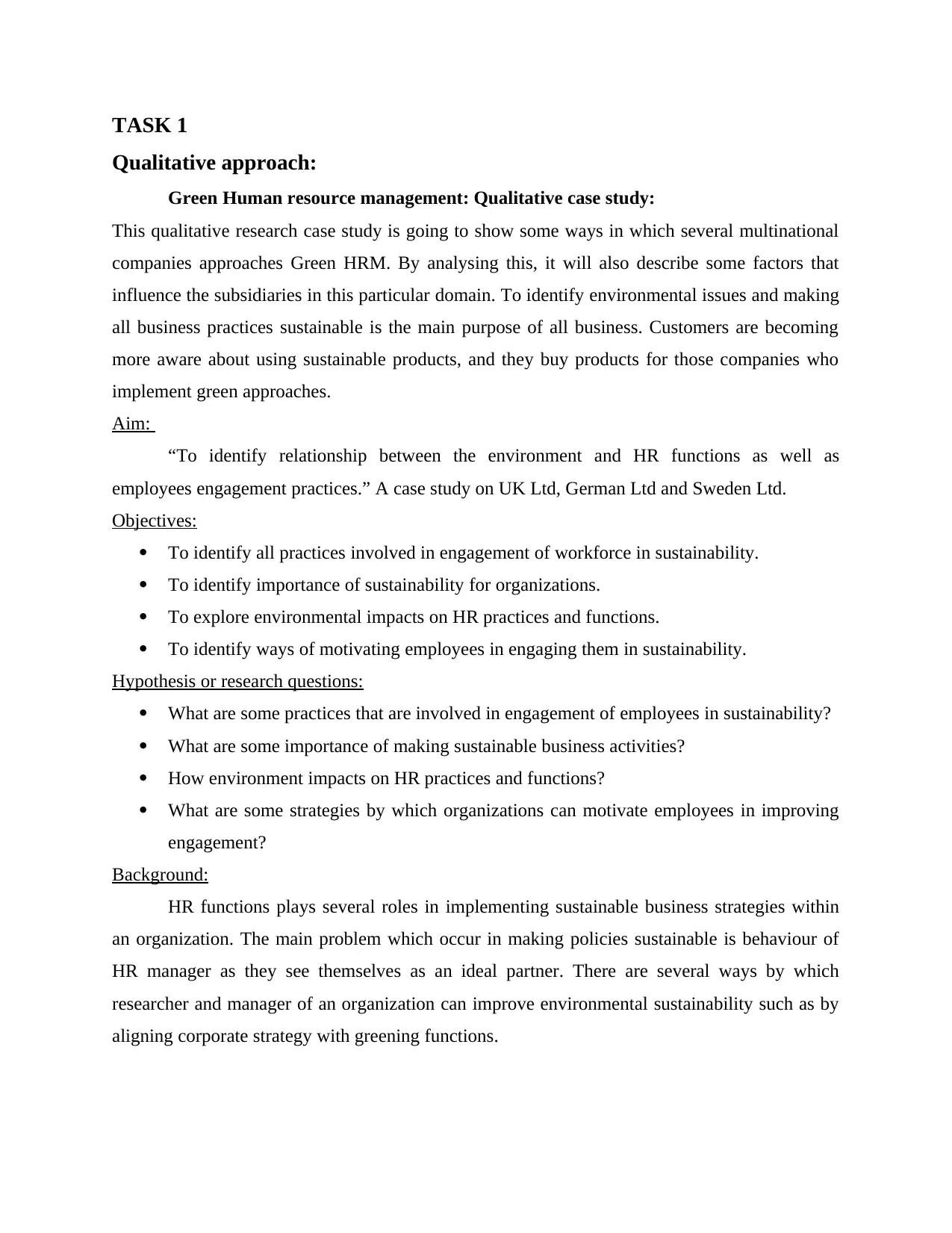
TASK 1
Qualitative approach:
Green Human resource management: Qualitative case study:
This qualitative research case study is going to show some ways in which several multinational
companies approaches Green HRM. By analysing this, it will also describe some factors that
influence the subsidiaries in this particular domain. To identify environmental issues and making
all business practices sustainable is the main purpose of all business. Customers are becoming
more aware about using sustainable products, and they buy products for those companies who
implement green approaches.
Aim:
“To identify relationship between the environment and HR functions as well as
employees engagement practices.” A case study on UK Ltd, German Ltd and Sweden Ltd.
Objectives:
To identify all practices involved in engagement of workforce in sustainability.
To identify importance of sustainability for organizations.
To explore environmental impacts on HR practices and functions.
To identify ways of motivating employees in engaging them in sustainability.
Hypothesis or research questions:
What are some practices that are involved in engagement of employees in sustainability?
What are some importance of making sustainable business activities?
How environment impacts on HR practices and functions?
What are some strategies by which organizations can motivate employees in improving
engagement?
Background:
HR functions plays several roles in implementing sustainable business strategies within
an organization. The main problem which occur in making policies sustainable is behaviour of
HR manager as they see themselves as an ideal partner. There are several ways by which
researcher and manager of an organization can improve environmental sustainability such as by
aligning corporate strategy with greening functions.
Qualitative approach:
Green Human resource management: Qualitative case study:
This qualitative research case study is going to show some ways in which several multinational
companies approaches Green HRM. By analysing this, it will also describe some factors that
influence the subsidiaries in this particular domain. To identify environmental issues and making
all business practices sustainable is the main purpose of all business. Customers are becoming
more aware about using sustainable products, and they buy products for those companies who
implement green approaches.
Aim:
“To identify relationship between the environment and HR functions as well as
employees engagement practices.” A case study on UK Ltd, German Ltd and Sweden Ltd.
Objectives:
To identify all practices involved in engagement of workforce in sustainability.
To identify importance of sustainability for organizations.
To explore environmental impacts on HR practices and functions.
To identify ways of motivating employees in engaging them in sustainability.
Hypothesis or research questions:
What are some practices that are involved in engagement of employees in sustainability?
What are some importance of making sustainable business activities?
How environment impacts on HR practices and functions?
What are some strategies by which organizations can motivate employees in improving
engagement?
Background:
HR functions plays several roles in implementing sustainable business strategies within
an organization. The main problem which occur in making policies sustainable is behaviour of
HR manager as they see themselves as an ideal partner. There are several ways by which
researcher and manager of an organization can improve environmental sustainability such as by
aligning corporate strategy with greening functions.
⊘ This is a preview!⊘
Do you want full access?
Subscribe today to unlock all pages.

Trusted by 1+ million students worldwide
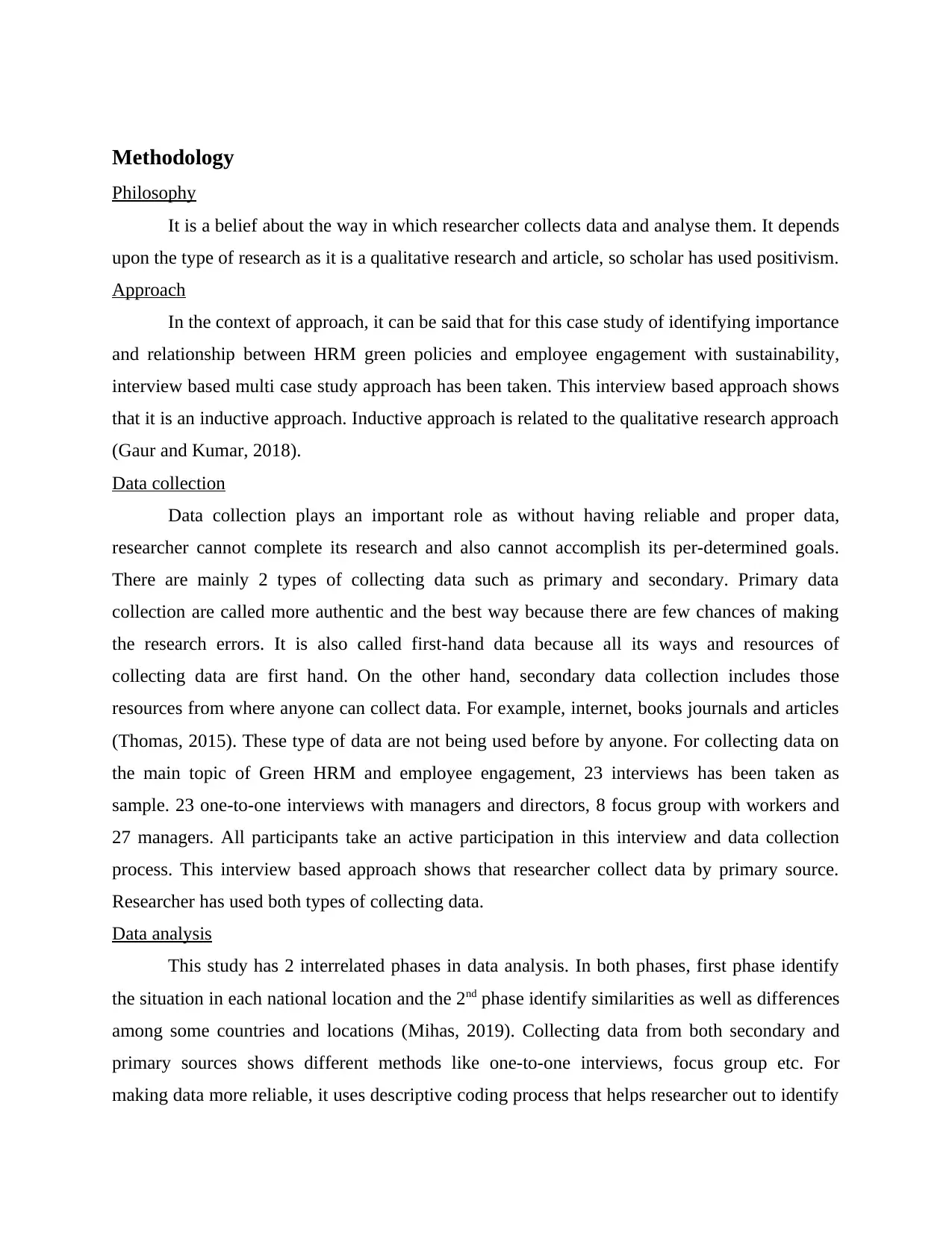
Methodology
Philosophy
It is a belief about the way in which researcher collects data and analyse them. It depends
upon the type of research as it is a qualitative research and article, so scholar has used positivism.
Approach
In the context of approach, it can be said that for this case study of identifying importance
and relationship between HRM green policies and employee engagement with sustainability,
interview based multi case study approach has been taken. This interview based approach shows
that it is an inductive approach. Inductive approach is related to the qualitative research approach
(Gaur and Kumar, 2018).
Data collection
Data collection plays an important role as without having reliable and proper data,
researcher cannot complete its research and also cannot accomplish its per-determined goals.
There are mainly 2 types of collecting data such as primary and secondary. Primary data
collection are called more authentic and the best way because there are few chances of making
the research errors. It is also called first-hand data because all its ways and resources of
collecting data are first hand. On the other hand, secondary data collection includes those
resources from where anyone can collect data. For example, internet, books journals and articles
(Thomas, 2015). These type of data are not being used before by anyone. For collecting data on
the main topic of Green HRM and employee engagement, 23 interviews has been taken as
sample. 23 one-to-one interviews with managers and directors, 8 focus group with workers and
27 managers. All participants take an active participation in this interview and data collection
process. This interview based approach shows that researcher collect data by primary source.
Researcher has used both types of collecting data.
Data analysis
This study has 2 interrelated phases in data analysis. In both phases, first phase identify
the situation in each national location and the 2nd phase identify similarities as well as differences
among some countries and locations (Mihas, 2019). Collecting data from both secondary and
primary sources shows different methods like one-to-one interviews, focus group etc. For
making data more reliable, it uses descriptive coding process that helps researcher out to identify
Philosophy
It is a belief about the way in which researcher collects data and analyse them. It depends
upon the type of research as it is a qualitative research and article, so scholar has used positivism.
Approach
In the context of approach, it can be said that for this case study of identifying importance
and relationship between HRM green policies and employee engagement with sustainability,
interview based multi case study approach has been taken. This interview based approach shows
that it is an inductive approach. Inductive approach is related to the qualitative research approach
(Gaur and Kumar, 2018).
Data collection
Data collection plays an important role as without having reliable and proper data,
researcher cannot complete its research and also cannot accomplish its per-determined goals.
There are mainly 2 types of collecting data such as primary and secondary. Primary data
collection are called more authentic and the best way because there are few chances of making
the research errors. It is also called first-hand data because all its ways and resources of
collecting data are first hand. On the other hand, secondary data collection includes those
resources from where anyone can collect data. For example, internet, books journals and articles
(Thomas, 2015). These type of data are not being used before by anyone. For collecting data on
the main topic of Green HRM and employee engagement, 23 interviews has been taken as
sample. 23 one-to-one interviews with managers and directors, 8 focus group with workers and
27 managers. All participants take an active participation in this interview and data collection
process. This interview based approach shows that researcher collect data by primary source.
Researcher has used both types of collecting data.
Data analysis
This study has 2 interrelated phases in data analysis. In both phases, first phase identify
the situation in each national location and the 2nd phase identify similarities as well as differences
among some countries and locations (Mihas, 2019). Collecting data from both secondary and
primary sources shows different methods like one-to-one interviews, focus group etc. For
making data more reliable, it uses descriptive coding process that helps researcher out to identify
Paraphrase This Document
Need a fresh take? Get an instant paraphrase of this document with our AI Paraphraser
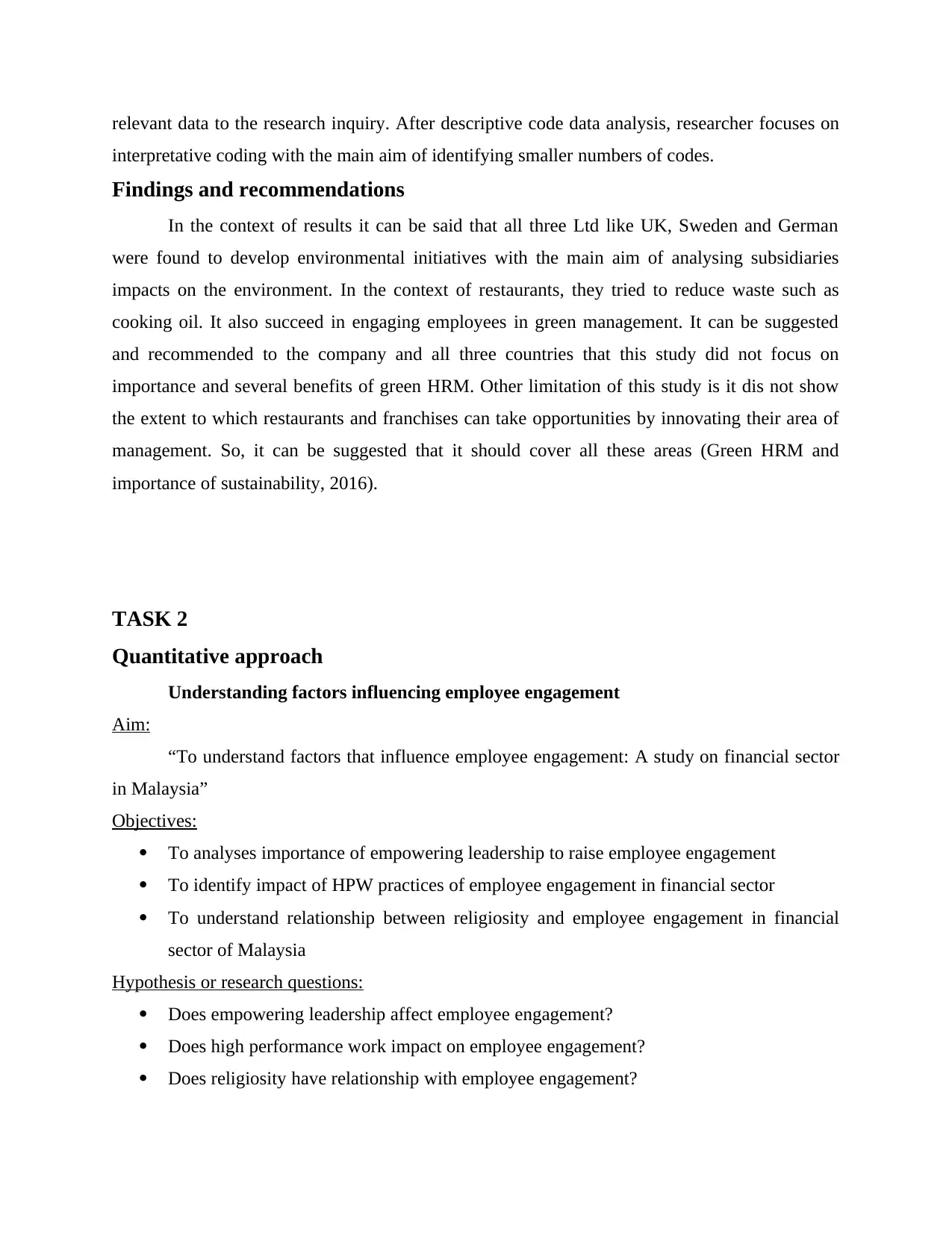
relevant data to the research inquiry. After descriptive code data analysis, researcher focuses on
interpretative coding with the main aim of identifying smaller numbers of codes.
Findings and recommendations
In the context of results it can be said that all three Ltd like UK, Sweden and German
were found to develop environmental initiatives with the main aim of analysing subsidiaries
impacts on the environment. In the context of restaurants, they tried to reduce waste such as
cooking oil. It also succeed in engaging employees in green management. It can be suggested
and recommended to the company and all three countries that this study did not focus on
importance and several benefits of green HRM. Other limitation of this study is it dis not show
the extent to which restaurants and franchises can take opportunities by innovating their area of
management. So, it can be suggested that it should cover all these areas (Green HRM and
importance of sustainability, 2016).
TASK 2
Quantitative approach
Understanding factors influencing employee engagement
Aim:
“To understand factors that influence employee engagement: A study on financial sector
in Malaysia”
Objectives:
To analyses importance of empowering leadership to raise employee engagement
To identify impact of HPW practices of employee engagement in financial sector
To understand relationship between religiosity and employee engagement in financial
sector of Malaysia
Hypothesis or research questions:
Does empowering leadership affect employee engagement?
Does high performance work impact on employee engagement?
Does religiosity have relationship with employee engagement?
interpretative coding with the main aim of identifying smaller numbers of codes.
Findings and recommendations
In the context of results it can be said that all three Ltd like UK, Sweden and German
were found to develop environmental initiatives with the main aim of analysing subsidiaries
impacts on the environment. In the context of restaurants, they tried to reduce waste such as
cooking oil. It also succeed in engaging employees in green management. It can be suggested
and recommended to the company and all three countries that this study did not focus on
importance and several benefits of green HRM. Other limitation of this study is it dis not show
the extent to which restaurants and franchises can take opportunities by innovating their area of
management. So, it can be suggested that it should cover all these areas (Green HRM and
importance of sustainability, 2016).
TASK 2
Quantitative approach
Understanding factors influencing employee engagement
Aim:
“To understand factors that influence employee engagement: A study on financial sector
in Malaysia”
Objectives:
To analyses importance of empowering leadership to raise employee engagement
To identify impact of HPW practices of employee engagement in financial sector
To understand relationship between religiosity and employee engagement in financial
sector of Malaysia
Hypothesis or research questions:
Does empowering leadership affect employee engagement?
Does high performance work impact on employee engagement?
Does religiosity have relationship with employee engagement?
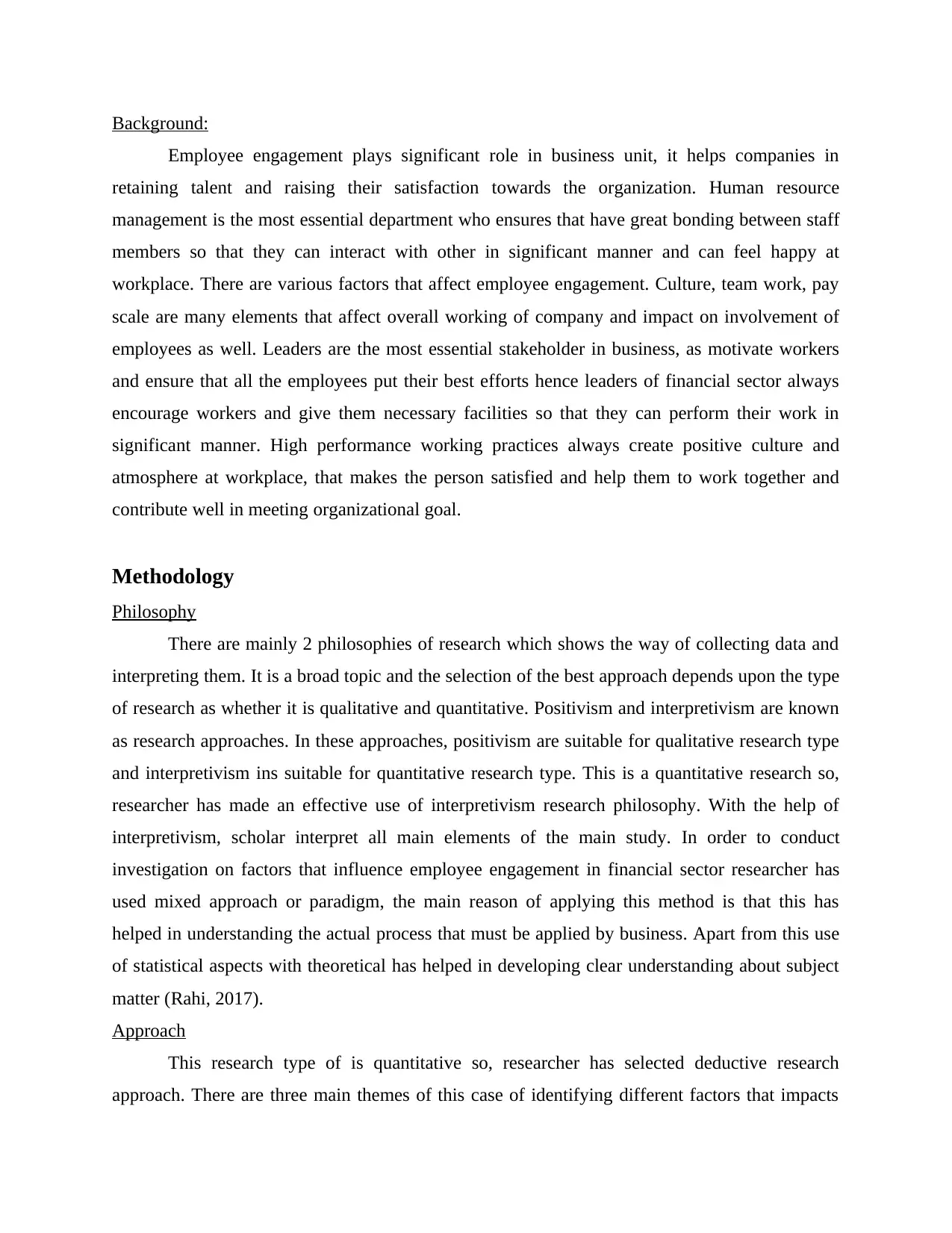
Background:
Employee engagement plays significant role in business unit, it helps companies in
retaining talent and raising their satisfaction towards the organization. Human resource
management is the most essential department who ensures that have great bonding between staff
members so that they can interact with other in significant manner and can feel happy at
workplace. There are various factors that affect employee engagement. Culture, team work, pay
scale are many elements that affect overall working of company and impact on involvement of
employees as well. Leaders are the most essential stakeholder in business, as motivate workers
and ensure that all the employees put their best efforts hence leaders of financial sector always
encourage workers and give them necessary facilities so that they can perform their work in
significant manner. High performance working practices always create positive culture and
atmosphere at workplace, that makes the person satisfied and help them to work together and
contribute well in meeting organizational goal.
Methodology
Philosophy
There are mainly 2 philosophies of research which shows the way of collecting data and
interpreting them. It is a broad topic and the selection of the best approach depends upon the type
of research as whether it is qualitative and quantitative. Positivism and interpretivism are known
as research approaches. In these approaches, positivism are suitable for qualitative research type
and interpretivism ins suitable for quantitative research type. This is a quantitative research so,
researcher has made an effective use of interpretivism research philosophy. With the help of
interpretivism, scholar interpret all main elements of the main study. In order to conduct
investigation on factors that influence employee engagement in financial sector researcher has
used mixed approach or paradigm, the main reason of applying this method is that this has
helped in understanding the actual process that must be applied by business. Apart from this use
of statistical aspects with theoretical has helped in developing clear understanding about subject
matter (Rahi, 2017).
Approach
This research type of is quantitative so, researcher has selected deductive research
approach. There are three main themes of this case of identifying different factors that impacts
Employee engagement plays significant role in business unit, it helps companies in
retaining talent and raising their satisfaction towards the organization. Human resource
management is the most essential department who ensures that have great bonding between staff
members so that they can interact with other in significant manner and can feel happy at
workplace. There are various factors that affect employee engagement. Culture, team work, pay
scale are many elements that affect overall working of company and impact on involvement of
employees as well. Leaders are the most essential stakeholder in business, as motivate workers
and ensure that all the employees put their best efforts hence leaders of financial sector always
encourage workers and give them necessary facilities so that they can perform their work in
significant manner. High performance working practices always create positive culture and
atmosphere at workplace, that makes the person satisfied and help them to work together and
contribute well in meeting organizational goal.
Methodology
Philosophy
There are mainly 2 philosophies of research which shows the way of collecting data and
interpreting them. It is a broad topic and the selection of the best approach depends upon the type
of research as whether it is qualitative and quantitative. Positivism and interpretivism are known
as research approaches. In these approaches, positivism are suitable for qualitative research type
and interpretivism ins suitable for quantitative research type. This is a quantitative research so,
researcher has made an effective use of interpretivism research philosophy. With the help of
interpretivism, scholar interpret all main elements of the main study. In order to conduct
investigation on factors that influence employee engagement in financial sector researcher has
used mixed approach or paradigm, the main reason of applying this method is that this has
helped in understanding the actual process that must be applied by business. Apart from this use
of statistical aspects with theoretical has helped in developing clear understanding about subject
matter (Rahi, 2017).
Approach
This research type of is quantitative so, researcher has selected deductive research
approach. There are three main themes of this case of identifying different factors that impacts
⊘ This is a preview!⊘
Do you want full access?
Subscribe today to unlock all pages.

Trusted by 1+ million students worldwide
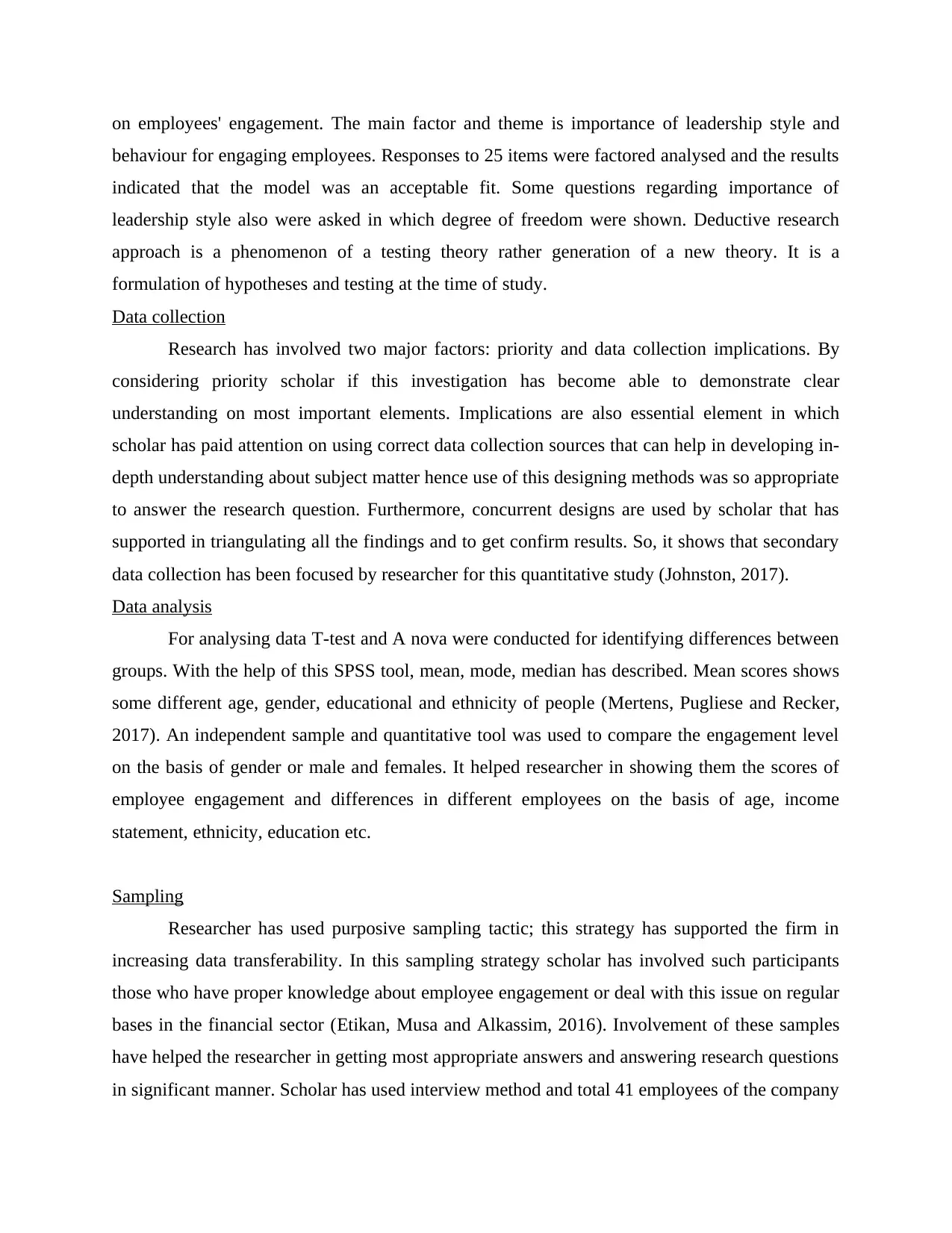
on employees' engagement. The main factor and theme is importance of leadership style and
behaviour for engaging employees. Responses to 25 items were factored analysed and the results
indicated that the model was an acceptable fit. Some questions regarding importance of
leadership style also were asked in which degree of freedom were shown. Deductive research
approach is a phenomenon of a testing theory rather generation of a new theory. It is a
formulation of hypotheses and testing at the time of study.
Data collection
Research has involved two major factors: priority and data collection implications. By
considering priority scholar if this investigation has become able to demonstrate clear
understanding on most important elements. Implications are also essential element in which
scholar has paid attention on using correct data collection sources that can help in developing in-
depth understanding about subject matter hence use of this designing methods was so appropriate
to answer the research question. Furthermore, concurrent designs are used by scholar that has
supported in triangulating all the findings and to get confirm results. So, it shows that secondary
data collection has been focused by researcher for this quantitative study (Johnston, 2017).
Data analysis
For analysing data T-test and A nova were conducted for identifying differences between
groups. With the help of this SPSS tool, mean, mode, median has described. Mean scores shows
some different age, gender, educational and ethnicity of people (Mertens, Pugliese and Recker,
2017). An independent sample and quantitative tool was used to compare the engagement level
on the basis of gender or male and females. It helped researcher in showing them the scores of
employee engagement and differences in different employees on the basis of age, income
statement, ethnicity, education etc.
Sampling
Researcher has used purposive sampling tactic; this strategy has supported the firm in
increasing data transferability. In this sampling strategy scholar has involved such participants
those who have proper knowledge about employee engagement or deal with this issue on regular
bases in the financial sector (Etikan, Musa and Alkassim, 2016). Involvement of these samples
have helped the researcher in getting most appropriate answers and answering research questions
in significant manner. Scholar has used interview method and total 41 employees of the company
behaviour for engaging employees. Responses to 25 items were factored analysed and the results
indicated that the model was an acceptable fit. Some questions regarding importance of
leadership style also were asked in which degree of freedom were shown. Deductive research
approach is a phenomenon of a testing theory rather generation of a new theory. It is a
formulation of hypotheses and testing at the time of study.
Data collection
Research has involved two major factors: priority and data collection implications. By
considering priority scholar if this investigation has become able to demonstrate clear
understanding on most important elements. Implications are also essential element in which
scholar has paid attention on using correct data collection sources that can help in developing in-
depth understanding about subject matter hence use of this designing methods was so appropriate
to answer the research question. Furthermore, concurrent designs are used by scholar that has
supported in triangulating all the findings and to get confirm results. So, it shows that secondary
data collection has been focused by researcher for this quantitative study (Johnston, 2017).
Data analysis
For analysing data T-test and A nova were conducted for identifying differences between
groups. With the help of this SPSS tool, mean, mode, median has described. Mean scores shows
some different age, gender, educational and ethnicity of people (Mertens, Pugliese and Recker,
2017). An independent sample and quantitative tool was used to compare the engagement level
on the basis of gender or male and females. It helped researcher in showing them the scores of
employee engagement and differences in different employees on the basis of age, income
statement, ethnicity, education etc.
Sampling
Researcher has used purposive sampling tactic; this strategy has supported the firm in
increasing data transferability. In this sampling strategy scholar has involved such participants
those who have proper knowledge about employee engagement or deal with this issue on regular
bases in the financial sector (Etikan, Musa and Alkassim, 2016). Involvement of these samples
have helped the researcher in getting most appropriate answers and answering research questions
in significant manner. Scholar has used interview method and total 41 employees of the company
Paraphrase This Document
Need a fresh take? Get an instant paraphrase of this document with our AI Paraphraser
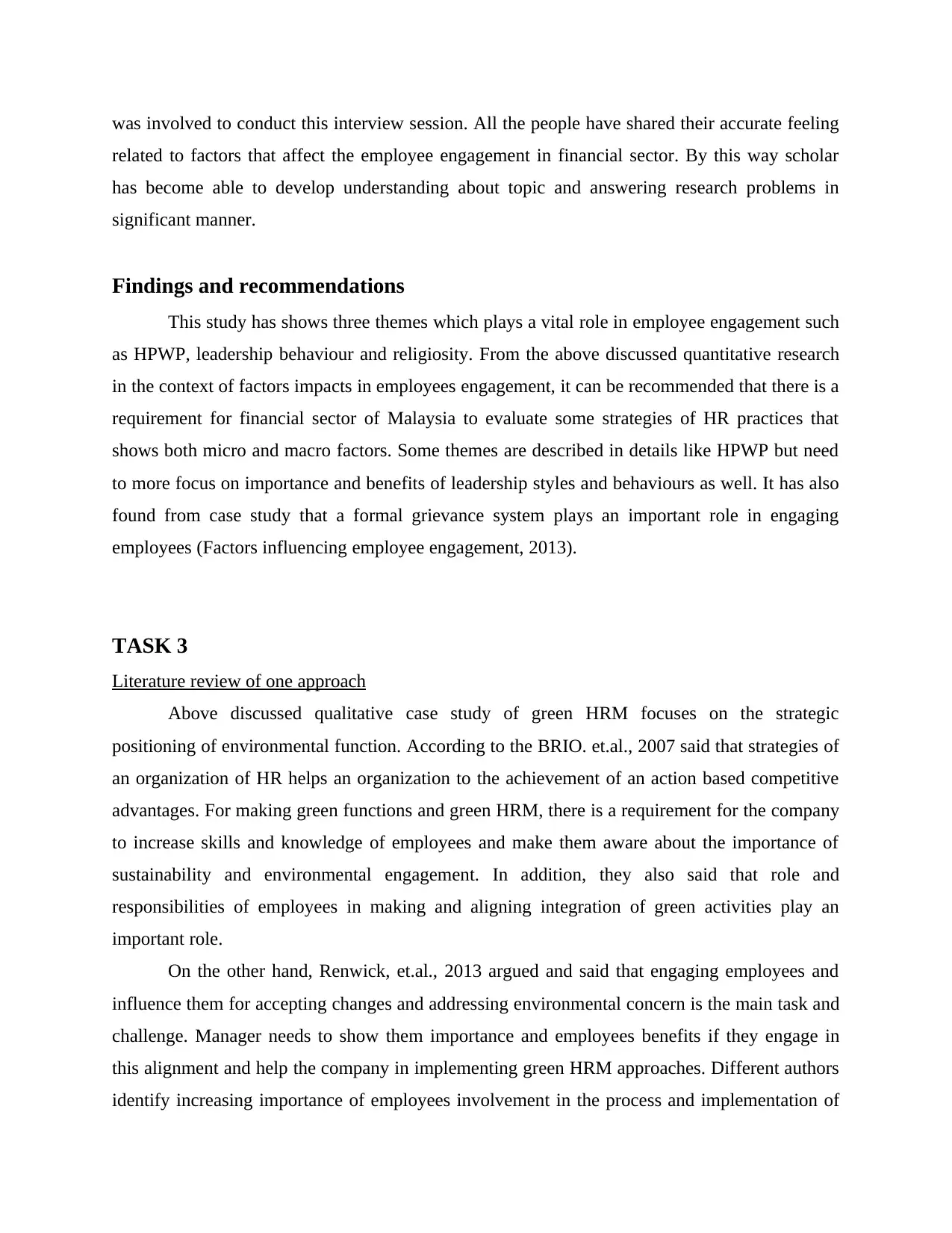
was involved to conduct this interview session. All the people have shared their accurate feeling
related to factors that affect the employee engagement in financial sector. By this way scholar
has become able to develop understanding about topic and answering research problems in
significant manner.
Findings and recommendations
This study has shows three themes which plays a vital role in employee engagement such
as HPWP, leadership behaviour and religiosity. From the above discussed quantitative research
in the context of factors impacts in employees engagement, it can be recommended that there is a
requirement for financial sector of Malaysia to evaluate some strategies of HR practices that
shows both micro and macro factors. Some themes are described in details like HPWP but need
to more focus on importance and benefits of leadership styles and behaviours as well. It has also
found from case study that a formal grievance system plays an important role in engaging
employees (Factors influencing employee engagement, 2013).
TASK 3
Literature review of one approach
Above discussed qualitative case study of green HRM focuses on the strategic
positioning of environmental function. According to the BRIO. et.al., 2007 said that strategies of
an organization of HR helps an organization to the achievement of an action based competitive
advantages. For making green functions and green HRM, there is a requirement for the company
to increase skills and knowledge of employees and make them aware about the importance of
sustainability and environmental engagement. In addition, they also said that role and
responsibilities of employees in making and aligning integration of green activities play an
important role.
On the other hand, Renwick, et.al., 2013 argued and said that engaging employees and
influence them for accepting changes and addressing environmental concern is the main task and
challenge. Manager needs to show them importance and employees benefits if they engage in
this alignment and help the company in implementing green HRM approaches. Different authors
identify increasing importance of employees involvement in the process and implementation of
related to factors that affect the employee engagement in financial sector. By this way scholar
has become able to develop understanding about topic and answering research problems in
significant manner.
Findings and recommendations
This study has shows three themes which plays a vital role in employee engagement such
as HPWP, leadership behaviour and religiosity. From the above discussed quantitative research
in the context of factors impacts in employees engagement, it can be recommended that there is a
requirement for financial sector of Malaysia to evaluate some strategies of HR practices that
shows both micro and macro factors. Some themes are described in details like HPWP but need
to more focus on importance and benefits of leadership styles and behaviours as well. It has also
found from case study that a formal grievance system plays an important role in engaging
employees (Factors influencing employee engagement, 2013).
TASK 3
Literature review of one approach
Above discussed qualitative case study of green HRM focuses on the strategic
positioning of environmental function. According to the BRIO. et.al., 2007 said that strategies of
an organization of HR helps an organization to the achievement of an action based competitive
advantages. For making green functions and green HRM, there is a requirement for the company
to increase skills and knowledge of employees and make them aware about the importance of
sustainability and environmental engagement. In addition, they also said that role and
responsibilities of employees in making and aligning integration of green activities play an
important role.
On the other hand, Renwick, et.al., 2013 argued and said that engaging employees and
influence them for accepting changes and addressing environmental concern is the main task and
challenge. Manager needs to show them importance and employees benefits if they engage in
this alignment and help the company in implementing green HRM approaches. Different authors
identify increasing importance of employees involvement in the process and implementation of
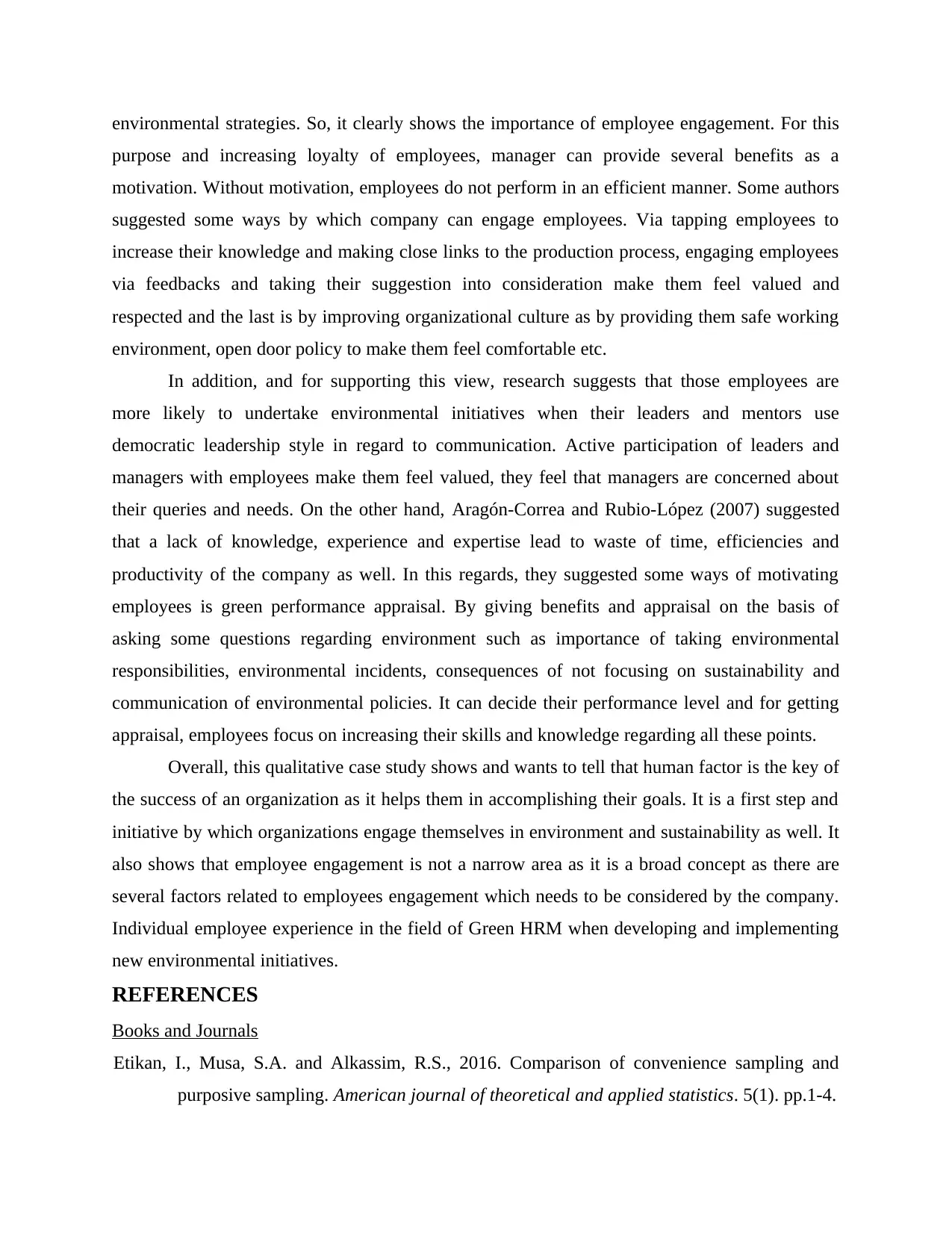
environmental strategies. So, it clearly shows the importance of employee engagement. For this
purpose and increasing loyalty of employees, manager can provide several benefits as a
motivation. Without motivation, employees do not perform in an efficient manner. Some authors
suggested some ways by which company can engage employees. Via tapping employees to
increase their knowledge and making close links to the production process, engaging employees
via feedbacks and taking their suggestion into consideration make them feel valued and
respected and the last is by improving organizational culture as by providing them safe working
environment, open door policy to make them feel comfortable etc.
In addition, and for supporting this view, research suggests that those employees are
more likely to undertake environmental initiatives when their leaders and mentors use
democratic leadership style in regard to communication. Active participation of leaders and
managers with employees make them feel valued, they feel that managers are concerned about
their queries and needs. On the other hand, Aragón-Correa and Rubio-López (2007) suggested
that a lack of knowledge, experience and expertise lead to waste of time, efficiencies and
productivity of the company as well. In this regards, they suggested some ways of motivating
employees is green performance appraisal. By giving benefits and appraisal on the basis of
asking some questions regarding environment such as importance of taking environmental
responsibilities, environmental incidents, consequences of not focusing on sustainability and
communication of environmental policies. It can decide their performance level and for getting
appraisal, employees focus on increasing their skills and knowledge regarding all these points.
Overall, this qualitative case study shows and wants to tell that human factor is the key of
the success of an organization as it helps them in accomplishing their goals. It is a first step and
initiative by which organizations engage themselves in environment and sustainability as well. It
also shows that employee engagement is not a narrow area as it is a broad concept as there are
several factors related to employees engagement which needs to be considered by the company.
Individual employee experience in the field of Green HRM when developing and implementing
new environmental initiatives.
REFERENCES
Books and Journals
Etikan, I., Musa, S.A. and Alkassim, R.S., 2016. Comparison of convenience sampling and
purposive sampling. American journal of theoretical and applied statistics. 5(1). pp.1-4.
purpose and increasing loyalty of employees, manager can provide several benefits as a
motivation. Without motivation, employees do not perform in an efficient manner. Some authors
suggested some ways by which company can engage employees. Via tapping employees to
increase their knowledge and making close links to the production process, engaging employees
via feedbacks and taking their suggestion into consideration make them feel valued and
respected and the last is by improving organizational culture as by providing them safe working
environment, open door policy to make them feel comfortable etc.
In addition, and for supporting this view, research suggests that those employees are
more likely to undertake environmental initiatives when their leaders and mentors use
democratic leadership style in regard to communication. Active participation of leaders and
managers with employees make them feel valued, they feel that managers are concerned about
their queries and needs. On the other hand, Aragón-Correa and Rubio-López (2007) suggested
that a lack of knowledge, experience and expertise lead to waste of time, efficiencies and
productivity of the company as well. In this regards, they suggested some ways of motivating
employees is green performance appraisal. By giving benefits and appraisal on the basis of
asking some questions regarding environment such as importance of taking environmental
responsibilities, environmental incidents, consequences of not focusing on sustainability and
communication of environmental policies. It can decide their performance level and for getting
appraisal, employees focus on increasing their skills and knowledge regarding all these points.
Overall, this qualitative case study shows and wants to tell that human factor is the key of
the success of an organization as it helps them in accomplishing their goals. It is a first step and
initiative by which organizations engage themselves in environment and sustainability as well. It
also shows that employee engagement is not a narrow area as it is a broad concept as there are
several factors related to employees engagement which needs to be considered by the company.
Individual employee experience in the field of Green HRM when developing and implementing
new environmental initiatives.
REFERENCES
Books and Journals
Etikan, I., Musa, S.A. and Alkassim, R.S., 2016. Comparison of convenience sampling and
purposive sampling. American journal of theoretical and applied statistics. 5(1). pp.1-4.
⊘ This is a preview!⊘
Do you want full access?
Subscribe today to unlock all pages.

Trusted by 1+ million students worldwide
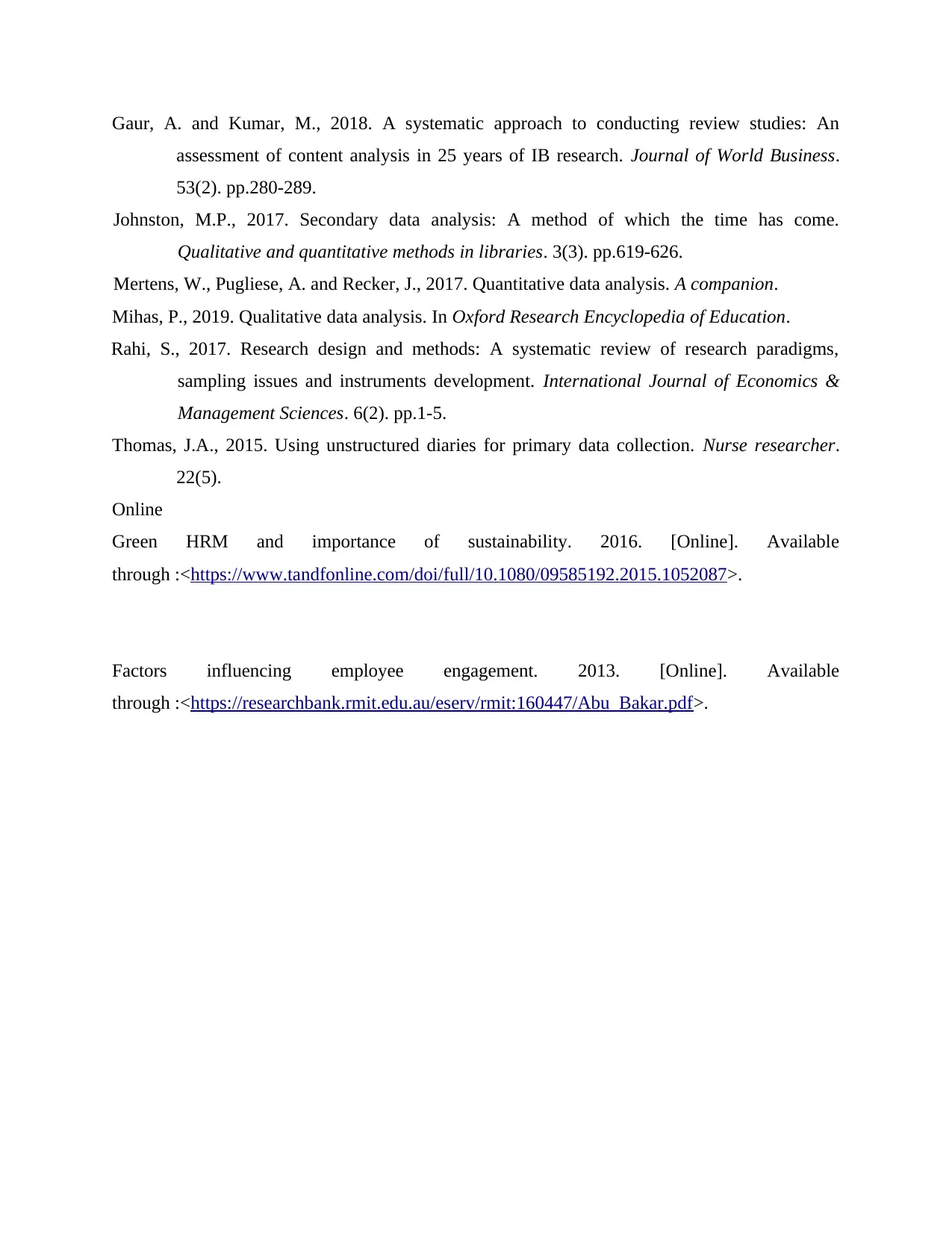
Gaur, A. and Kumar, M., 2018. A systematic approach to conducting review studies: An
assessment of content analysis in 25 years of IB research. Journal of World Business.
53(2). pp.280-289.
Johnston, M.P., 2017. Secondary data analysis: A method of which the time has come.
Qualitative and quantitative methods in libraries. 3(3). pp.619-626.
Mertens, W., Pugliese, A. and Recker, J., 2017. Quantitative data analysis. A companion.
Mihas, P., 2019. Qualitative data analysis. In Oxford Research Encyclopedia of Education.
Rahi, S., 2017. Research design and methods: A systematic review of research paradigms,
sampling issues and instruments development. International Journal of Economics &
Management Sciences. 6(2). pp.1-5.
Thomas, J.A., 2015. Using unstructured diaries for primary data collection. Nurse researcher.
22(5).
Online
Green HRM and importance of sustainability. 2016. [Online]. Available
through :<https://www.tandfonline.com/doi/full/10.1080/09585192.2015.1052087>.
Factors influencing employee engagement. 2013. [Online]. Available
through :<https://researchbank.rmit.edu.au/eserv/rmit:160447/Abu_Bakar.pdf>.
assessment of content analysis in 25 years of IB research. Journal of World Business.
53(2). pp.280-289.
Johnston, M.P., 2017. Secondary data analysis: A method of which the time has come.
Qualitative and quantitative methods in libraries. 3(3). pp.619-626.
Mertens, W., Pugliese, A. and Recker, J., 2017. Quantitative data analysis. A companion.
Mihas, P., 2019. Qualitative data analysis. In Oxford Research Encyclopedia of Education.
Rahi, S., 2017. Research design and methods: A systematic review of research paradigms,
sampling issues and instruments development. International Journal of Economics &
Management Sciences. 6(2). pp.1-5.
Thomas, J.A., 2015. Using unstructured diaries for primary data collection. Nurse researcher.
22(5).
Online
Green HRM and importance of sustainability. 2016. [Online]. Available
through :<https://www.tandfonline.com/doi/full/10.1080/09585192.2015.1052087>.
Factors influencing employee engagement. 2013. [Online]. Available
through :<https://researchbank.rmit.edu.au/eserv/rmit:160447/Abu_Bakar.pdf>.
Paraphrase This Document
Need a fresh take? Get an instant paraphrase of this document with our AI Paraphraser


⊘ This is a preview!⊘
Do you want full access?
Subscribe today to unlock all pages.

Trusted by 1+ million students worldwide
1 out of 14
Related Documents
Your All-in-One AI-Powered Toolkit for Academic Success.
+13062052269
info@desklib.com
Available 24*7 on WhatsApp / Email
![[object Object]](/_next/static/media/star-bottom.7253800d.svg)
Unlock your academic potential
Copyright © 2020–2025 A2Z Services. All Rights Reserved. Developed and managed by ZUCOL.





